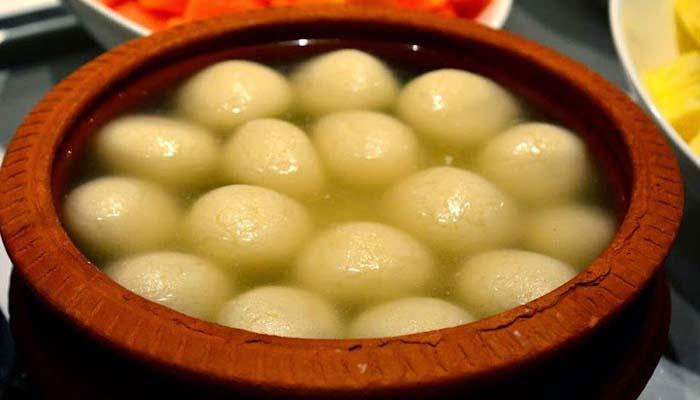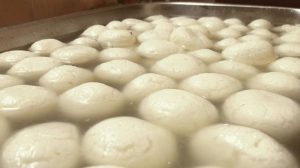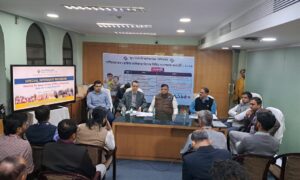
Picture For Representational Purpose Only
Every time Sishir Behera 44, visits Bhubaneswar, he makes it a point to drive down to Pahala and fill his stomach with Rasagolas. It’s a routine Sishir has been following since 1997, when he left the state to pursue his career in IT. “It’s a must- go destination for me. I love to taste the sweet delicacy in the evening for it’s a different charm altogether,” Sishir, a senior software designer with a French multinational, in Pune, said.
Sishir, is not alone. Pahala, generally identified with Rasagola- some netizens also call it the Rasagola district of Odisha- is a favorite spot to savor the round shaped sweet delicacy made of chhena, for almost everyone passing through the (Chennai-Kolkata) national highway between Bhubaneswar and Cuttack. “Over a decade ago, while travelling on this stretch, I was fascinated by the scores of shops, lit with tube lights and stacked with containers full of sweets, stretching over a kilometer on either side of the road. I have travelled around the country, but nowhere, I have seen so many mithai shops together. Of course, the Rasagola of that place is just amazing,” recalled Swati, a forty year old a Delhi based media professional.

Picture Courtesy : Deccan Chronicle
Indeed. The sight of the shops is difficult to miss. And, the Rasagolas they sell are hard to resist. Here, Rasagola has provided livelihood to around one thousand families, including those of the chhena and firewood suppliers. There are conflicting opinions about time the ‘sweet –trade’ began in Pahala- some believe it started in the mid1960’, but according to many, it’s at least a hundred year old business, here. Over the time, changes- forced ones though- primarily due to inflation, have been witnessed in Pahala. Apart from, Rasagola, other popular delicacies such as Chhena Poda and Chhena Gaja are being sold, as the confectioners say, “to offer the customers more choices”. Polythene bags have replaced the earthen pots to carry the sweets. “Due to rise in price we have been forced to reduce the size of the Rasagola,” conceded, Yasawant, a confectioner. However, neither time nor inflation has had any impact on the taste of the sweet gem-Rasogola.
On an average, each of the approximately 100 shops sells sweets of Rs.4,000-5,000 every day- it’s more during the marriage season and festivals. Rasagola is also supplied to the other cities of the state- Sambalpur, Bargarh, Rourkela, Kendujhar etc through the overnight buses. “We also supply our products to Kolkata and Jamshedpur in Jharkhand,” informs Akshay Lenka, President, Pahala Rasagola Entrepreneurs and Manufacturers Association.
The confectioners in Pahala are confident that Odisha Rasagola will bag the Geographical Indication (GI) tag, which they believe is a much deserved, honor. “We (Odisha) made Rasagola first, it’s a part and parcel of the Jagannath tradition and Odia culture,” they claimed.
For over two years, as the tussle over the origins of the sweet between the two coastal, eastern bordering states- Odisha and West Bengal- intensified, Pahala attracted a lot of media attention. In 2015, Odisha government had planned to apply for GI tag for Pahala Rasagola. Now, after the Bangalar Rosogolla bagged the tag this month, the Odisha government is all set to apply for the tag for the Jagannath temple Rasagola, ‘as it will be easier to support the application with historical evidence.’
According to the Odisha government, more than one committee set up to trace the origin of the sweet had pointed to “conclusive evidence” that ‘rasagola’ existed in the state for about 600 years. It said that historical research proved that the ‘rasagola’ originated in Puri, its (Rasagola) first avatar was ‘kheer mohana’, which later evolved into ‘Pahala rasagola’.
In response, the West Bengal government quoted 19-century history to claim that rosogolla was invented by Nabin Chandra Das, a famous sweetmeat maker, in 1868.
“Let’s know the truth”, said Asit Mohanty, “West Bengal has bagged the GI tag for the Banglar Rosogolla, not Rasagola as a whole.” Mohanty, a Jagannath cult historian and Sahitya academy award winner, headed a committee to detail the origin of Rasagola. “Any day, we can prove that it originated in Odisha many centuries before West Bengal, we have enough evidence with us,” he added.
According to a leading confectioner in Bhubaneswar-incidentally he is from West Bengal and has been operating in the city for over three decades, Rasagola or Rosogolla -as they are called in the two states- are different in taste, texture and color. The Rosogulla of Bengal is spongy and white, while that of Odisha is very soft and light brown in color. Even the syrups are also different.
Unlike the Bengali variety, the Rasagola of Odisha just melts in the mouth. “Personally I like the ones made in Odisha, he said, adding, “This delicate sweet doesn’t deserve a rough tussle. We need to focus on R&D, packaging and marketing of it.”


















